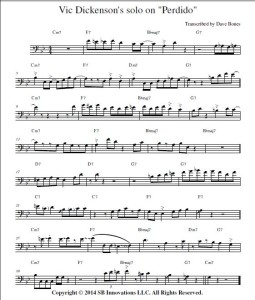Archive for the ‘Jazz Transcriptions’ Category
Jazz Trombone Vic Dickenson solo on Perdido
Check out this great example of jazz trombone. Vic Dickenson plays a wonderfully melodic solo over the changes to Perdido.
Jazz Trombone Vic Dickenson Transcription Assignment
Here is the PDF for the Jazz Trombone Vic Dickenson Transcription Assignment
Feel free to comment, and please let me know if you have any questions. Enjoy!
In learning jazz improvisation on the trombone, it is very important to make transcribing part of the curriculum for study.
One way to ease into transcribing is to transcribe excerpts from different players. If this inspires you to listen to more of the artist you started transcribing, well that’s great! At this stage of the game, listening is also critical. Having a teacher to help you “frame” the value, breathe life, and offer direction in your study to integrate listening and transcribing can be very beneficial.
In the brief video below, I play excerpts from the following three solos – J.J. Johnson, Misty; Carl Fontana, I Thought About You (including a supportive technical drill where no tongue is used to articulate the notes, but focus on air and embouchure. Then, the tongue is integrated again.); and, J.J. Johnson, Nutville.
Please let me know if you have any questions, or have any feedback to share. Enjoy!
Jazz Trombone Transcriptions to Transcribe and Why:
The 12 bar blues, and the chord changes to “I Got Rhythm” are a very rich part of jazz improvisation heritage. I recommend including in your learning to transcribe solos and songs based on these chord progressions for two reasons.
The first reason is because these chord progressions are so prevalent in jazz history. One thing that ties in this art worldwide is a common frame of reference in repertoire throughout the world. Whether you speak Italian, German, Mandarin Chinese, or any other language does not matter when you play with other jazz musicians from these countries. You will be able to play, and communicate through music together with this common knowledge of the blues and Rhythm Changes. How cool is that?
The second reason is that you will immediately get a lot of mileage for a smaller amount of work. Because many playing situations with other people will offer the opportunity to solo over these chord changes, you can immediately apply what you have learned.
I would encourage that you don’t have to be able to play through an entire transcription to benefit in ideas for soloing. Often, it can be beneficial to memorize and internalize just one or two measures that you find interesting, and can technically play. The next step would be to insert and develop that sound into different settings like over the blues, or other ideas.
Please see below for a few blues and Rhythm Changes solo transcriptions.
F Blues: Fred Wesley playing “Sandu”
Eb Blues: Curtis Fuller playing “Blue Train”
Db Blues: Mark Nightingale playing “On the Side”
Bb Blues: Michael Dease playing “Blues On the Corner”
Bb Rhythm Changes: Carl Fontana playing “I Got Rhythm”
Other considerations for jazz improvisation and transcribing
Another priority is to start hearing more “Tonic” sounds where the improvisor is basing his ideas on the I (Major or minor) chord; as well as, ii-7 V7 transitional sounds offering momentary tension.
Please see below for some examples. If not familiar with the chord progressions of the songs below, please feel free to refer to a lead sheet, or e-mail me for reference ideas.
Urbie Green playing “Lullaby of Birdland” in Ab:
Listen for the following in this track:
A Sections:
– F minor tonal (i minor) ideas
– Ab Major tonal (I chord) ideas
– ii-7 V7 I in Ab (|Bb-7 Eb7|AbMaj7 |)
– ii-7(b5) V7b9 i min in F minor (|G-7(b5) C7b9|Fmin |)
Bridge:
– ii-7(b5) V7b9 in Bb minor (|Cmin7(b5) F7b9| Bbmin |)
– ii-7(b5) V7b9 resolving to Ab Major (|Bb-7(b5) Eb7(b9)|AbMaj7 |)
Carl Fontana playiing “Hey There” in Ab:
Pay particular attention to the A sections on this track. Some points to consider are below:
– I V7/ii-7 ii-7 V7 (|AbMaj7 F7|Bb-7 Eb7|) for tonal ideas based in the key of Ab
– ii-7 V7 I in Ab Major (|Bb-7 Eb7|Ab Maj7 |)
– I V7/ii-7 ii-7 V7 (|CMaj7 A7|D-7 G7|) for tonal ideas based in the key of C
– ii-7 V7 I in C Major (|D-7 G7|C Maj7 |)
Feel free to e-mail me if you have questions, or if you would like to share some insight as well.
I wish you the best in your journey of discovery and improvisation!
Musically,
Dave Bones
